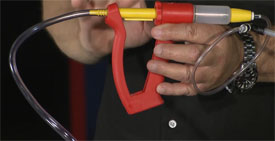Bleeding Brakes
We all know that bleeding your brakes is important, but we also know that it’s a pain to do. Pat has a product that lessens the sting.
Unfortunately, most drivers don’t do anything except check the level of their brake fluid and that’s a bad thing because brake fluid has the ability to attract and absorb moisture from the air around the car. And in about two year’s time, there could be enough moisture in the brake fluid to make the braking system in the car dangerous during a panic stop. Well, what do you do?
 Well, brake fluid should be flushed at least every two years. Now, flushing is no more than sophisticated bleeding; you’ve heard the term when technicians work on your car, they tell you they need to bleed the brakes. Well, bleeding the brakes is to get rid of air in the system. Well, flushing is no more than bleeding but we’re going to get rid of all of the old fluid in the system. Now it used to be that was a job that you had to take the car to the repair shop for, but today we have this system from Phoenix Systems. And what this is is a do it yourself bleeding kit that gives you the ability to bleed or flush the brakes on your car. Pretty simple, comes with instructions. You hook it up to the bleeder valve on the wheel cylinder or caliper on the car, whichever style brakes your car has. And you crack the bleeder valve about one half turn open. Now, before you start anything, you’ve got to make sure the master cylinder reservoir is full of the proper type of fluid. Once everything is set up, all you do is squeeze the handle on the bleeder; it will draw the old fluid out – you can actually see it through the hose. You continue bleeding it until you have fresh clean fluid coming through the hose. Also, make sure you keep the master cylinder reservoir full or you’ll run into problems. Now, that’s the way it’s done.
Well, brake fluid should be flushed at least every two years. Now, flushing is no more than sophisticated bleeding; you’ve heard the term when technicians work on your car, they tell you they need to bleed the brakes. Well, bleeding the brakes is to get rid of air in the system. Well, flushing is no more than bleeding but we’re going to get rid of all of the old fluid in the system. Now it used to be that was a job that you had to take the car to the repair shop for, but today we have this system from Phoenix Systems. And what this is is a do it yourself bleeding kit that gives you the ability to bleed or flush the brakes on your car. Pretty simple, comes with instructions. You hook it up to the bleeder valve on the wheel cylinder or caliper on the car, whichever style brakes your car has. And you crack the bleeder valve about one half turn open. Now, before you start anything, you’ve got to make sure the master cylinder reservoir is full of the proper type of fluid. Once everything is set up, all you do is squeeze the handle on the bleeder; it will draw the old fluid out – you can actually see it through the hose. You continue bleeding it until you have fresh clean fluid coming through the hose. Also, make sure you keep the master cylinder reservoir full or you’ll run into problems. Now, that’s the way it’s done.
After you’ve completed each wheel, you simply tighten the bleeder valve, remove the apparatus and move it to the next one. But what is the sequence? Well, the sequence is you pick either rear wheel; you bleed that one completely, wash it out. Then, you go to the opposite front wheel. Once that’s done, you go to the remaining rear wheel and then finally to the remaining front wheel that is opposite of that last rear wheel. This will get all of the old fluid out, you’ll have a much safer brake system on your car and the parts in the brake system will actually last longer. If you have a question or comment, drop me a line right here at MotorWeek.






